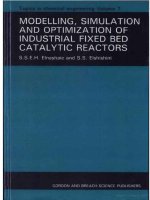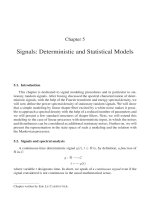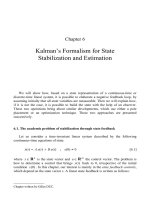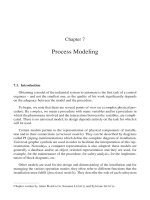Modelling, simulation, and control of polymorphic crystallization
Bạn đang xem bản rút gọn của tài liệu. Xem và tải ngay bản đầy đủ của tài liệu tại đây (1.34 MB, 244 trang )
MODELLING, SIMULATION, AND CONTROL OF POLYMORPHIC
CRYSTALLIZATION
MARTIN WIJAYA HERMANTO
(B. Eng. (Hons.), NUS)
A THESIS SUBMITTED
FOR THE DEGREE OF DOCTOR OF PHILOSOPHY
DEPARTMENT OF CHEMICAL AND BIOMOLECULAR ENGINEERING
NATIONAL UNIVERSITY OF SINGAPORE
2008
Acknowledgements
I would like to express my deep and sincere gratitude to my supervisors, Dr. Min-
Sen Chiu and Dr. Richard D. Braatz, for their constant support and guidance
throughout my PhD study at National University of Singapore. This thesis would
not have been possible without their inspiration, encouragement and their detailed
and constructive comments on my research.
I sincerely thank Dr. Lakshminarayanan Samavedham and Dr. Qing-Guo Wang
for their priceless inputs and advices during PhD oral examination. I warmly thank
all my lab mates, Dr. Yasuki Kansha, Ye Myint Hlaing, Ankush Gameshreddy
Kalmukale, Bu Xu, Yan Li, Xin Yang, and Imma Nuella for their moral support and
help rendered to me. My special thanks to Mr. Boey Kok Hong who has provided
his continuous assistance to make a workstation ready and available for my research
and to all academic and administrative staffs in the Chemical and Biomolecular
Engineering Department who have directly and indirectly help with my research
work. I am indebted to the National University of Singapore for the outstanding
research facilities and the research scholarship provided for my research.
i
ACKNOWLEDGEMENTS ii
I am very grateful to my wife, Fonny, for her constant moral supports, encour-
agements, and prayers which fire up my spirit when I faced obstacles and difficulties
in my research. I am greatly indebted to my parents and family for their concerns
and supports. Last but not least, I thank and praise my God, Jesus Christ, for His
grace and wisdom, without which I will not be able to finish this research.
Contents
Acknowledgements i
Table of Contents iii
Summary vii
List of Tables x
List of Figures xii
Nomenclature xxii
Abbreviations xxix
1 Introduction 1
1.1 Motivation 1
1.2 Contributions 3
1.3 Thesis Organization 7
2 Literature Review 8
iii
CONTENTS iv
2.1 Crystallization fundamentals 8
2.1.1 The driving force for crystallization 9
2.1.2 Nucleation 10
2.1.3 Growth 13
2.1.4 Polymorphism 15
2.2 Recent development on the modelling, simulation, and control of
crystallization 18
2.2.1 Modelling 18
2.2.2 Simulations 20
2.2.3 Control 22
3 Modelling the Crystallization of L-glutamic Acid Polymorphs 27
3.1 Introduction 27
3.2 Experimental methods 29
3.2.1 Calibration for solution concentration 30
3.2.2 Solubility determination and feedback concentration con-
trol experiments 31
3.3 Review of Bayesian inference 33
3.3.1 Bayesian posterior 33
3.3.2 Markov chain simulation 36
3.3.3 Monte Carlo integration 41
3.4 L-glutamic acid crystallization model 43
CONTENTS v
3.4.1 Kinetic model 44
3.4.2 Parameter estimation 48
3.5 Conclusions 65
4 High-order Simulation of Polymorphic Crystallization 66
4.1 Introduction 66
4.2 Numerical methods 69
4.2.1 WENO variants 72
4.2.2 High resolution (HR) method 79
4.2.3 The second-order finite difference (FD2) method 81
4.3 Simulation results 82
4.4 Conclusions 91
5 Temperature and Concentration Control Strategies 92
5.1 Introduction 92
5.2 Product quality, process constraints, and parameter perturbations 94
5.3 T-control and C-control strategies 96
5.4 Simulation results 101
5.5 Conclusions 111
6 Nonlinear Model Predictive Control Strategy 112
6.1 Introduction 112
6.2 System representation and NMPC strategy 114
CONTENTS vi
6.3 Unscented Kalman filter 123
6.4 Simulation results and discussion 129
6.4.1 Description of specific control implementations 129
6.4.2 Comparison results and discussion 131
6.5 Conclusions 140
7 Integrated Nonlinear MPC and Batch-to-Batch Control Strategy 141
7.1 Introduction 141
7.2 Batch-to-batch (B2B) control strategy 144
7.3 Integrated NMPC and batch-to-batch (NMPC-B2B) control strategy 148
7.4 Simulation results and discussion 155
7.4.1 Description of specific control implementations 155
7.4.2 Comparison results and discussion 156
7.5 Conclusions 159
8 Conclusions and Future Work 173
8.1 Conclusions 173
8.2 Suggestions for future work 176
Appendix A Quadratic Partial Least Squares 179
References 184
Publications and Presentations 210
Summary
Polymorphism, in which multiple crystal forms exist for the same chemical com-
pound, is of significant interest to industry. The variation in physical properties
such as crystal shape, solubility, hardness, colour, melting point, and chemical re-
activity makes polymorphism an important issue for the food, specialty chemical,
and pharmaceutical industries, where products are specified not only by chemical
composition, but also by their performance. Controlling polymorphism to ensure
consistent production of the desired polymorph is important in those industries,
including drug manufacturing where safety is paramount. In this thesis, the mod-
elling, simulation, and control of polymorphic crystallization of L-glutamic acid,
comprising the metastable α-form and the stable β-form crystals, are investigated.
With the ultimate goal being to better understand the effects of process condi-
tions on crystal quality and to control the formation of the desired polymorph, a
kinetic model for polymorphic crystallization of L-glutamic acid based on popula-
tion balance equations is developed using Bayesian inference. Such a process model
can facilitate the determination of optimal operating conditions and speed process
vii
SUMMARY viii
development, compared to time-consuming and expensive trial-and-error methods
for determining the operating conditions. The developed kinetic model appears to
be the first to include all of the transformation kinetic parameters including depen-
dence on the temperature, compared to past studies on the modelling of L-Glutamic
acid crystallization.
Next, numerical simulation of the developed model is investigated. It is impor-
tant to have efficient and sufficiently accurate computational methods for simulating
the population balance equations to ensure the behaviour of the numerical solution
is determined by the assumed physical principles and not by the chosen numerical
method. In this thesis, the high-order weighted essentially non-oscillatory (WENO)
methods are investigated and shown to give better computational efficiency com-
pared to the high resolution (HR) and the standard second-order finite difference
(FD2) methods to simulate the model of polymorphic crystallization of L-glutamic
acid developed in this thesis.
In non-polymorphic crystallization, the two most popular control strategies are
the temperature control (T-control) and concentration control (C-control) strategies.
In this study, the robustness of these control strategies are investigated in poly-
morphic crystallization using the model developed in this thesis. Simulation studies
show that T-control is not robust to kinetics perturbations, while C-control performs
very robustly but long batch times may be required.
Despite the high impact of model predictive control (MPC) in academic research
and industrial practice, its application to solution crystallization processes has been
SUMMARY ix
rather limited and there is no published result on the implementation of MPC or
nonlinear MPC (NMPC) to a polymorphic crystallization, which is more challeng-
ing. In this thesis, an efficient NMPC strategy based on the extended predictive
self-adaptive control (EPSAC) which does not rely on nonlinear programming is
developed for the polymorphic transformation process. Compared to the T-control,
C-control, and quadratic matrix control with successive linearization (SL-QDMC),
simulation results show that the NMPC strategy gives good overall robustness while
satisfying all constraints on manipulated and state variables within the specified
batch time.
Finally, exploiting the repetitive nature of batch processes, an integrated non-
linear model predictive control and batch-to-batch (NMPC-B2B) control strategy
based on a hybrid model is developed for the polymorphic transformation process.
The hybrid model consists of a first-principles model and a PLS model, where infor-
mation from the previous batches are utilized to update the control trajectory in the
next batch. The proposed NMPC-B2B strategy allows the NMPC to perform online
control which handle the constraints effectively while the batch-to-batch control re-
fines the model by learning from the previous batches. Compared to the standard
batch-to-batch (B2B) control strategy, the proposed NMPC-B2B control strategy
gives better performance where it satisfies all the state constraints and produces
faster and smoother convergence. In addition, it is verified that through the learning
process, both B2B and NMPC-B2B control strategies are more advantageous to be
employed to address the plant-model mismatch in an effective manner.
List of Tables
3.1 L-glutamic acid aqueous solutions used for calibration. 30
3.2 Solubility data for L-glutamic acid polymorphs. 32
3.3 Values for densities, volume shape factors, and saturation concen-
tration parameters. 47
3.4 Seed crystal size distribution data and the purity of α-form crystals
at the end of batch (x
α
). 53
3.5 Definition of measured variables y and interested parameters θ for
α- and β-seeded experiments. 54
3.6 The model parameters determined from parameter estimation. 54
3.7 Seed crystal size distribution data and the purity of α-form crystals
at the end of batch (x
α
) for model validation. 54
4.1 Values of h and d
m
for LOCWENO, JSHWENO, and WPower-
ENO methods. 76
4.2 Initial seed distribution parameters for α- and β-forms. 85
4.3 L
1
self-convergence order (O
L
1
) for the various numerical methods. 85
x
LIST OF TABLES xi
5.1 The parameters describing the seed distributions. 96
5.2 Variations in model parameters for robustness study: Case 1 is the
nominal model, Case 2 has slow nucleation and fast growth rate
parameters for β-form crystals, and Case 3 has fast nucleation and
slow growth rate parameters for β-form crystals. 96
5.3 Values of the control objective P
1
obtained for the three sets of
model parameters in Table 5.2. 104
5.4 Values of the control objective P
2
obtained for the three sets of
model parameters in Table 5.2. 104
6.1 Tuning parameters for the NMPC strategy. 133
6.2 Values of the control objective P
1
obtained for the three sets of
model parameters in Table 5.2. 133
6.3 Values of the control objective P
2
obtained for the three sets of
model parameters in Table 5.2. 133
7.1 Tuning parameters for the B2B control strategy. 158
7.2 Tuning parameters for the NMPC-B2B control strategy. 158
7.3 Values of the control objective P
1
obtained for the Cases 2 and 3 in
Table 5.2. 158
7.4 Values of the control objective P
2
obtained for the Cases 2 and 3 in
Table 5.2. 159
List of Figures
2.1 Solubility diagram. 10
2.2 Nucleation mechanism. 10
2.3 Crystal incorporation sites: flat faces (A), step sites (B), and kink
sites (C). 14
2.4 Solubility curves in polymorphic systems. 16
3.1 Solubility curves of L-glutamic acid polymorphs. 32
3.2 Experimental and model trajectories for (a) temperature, (b) the
first-order moment of the α-form crystals, and (c) solute concen-
tration for Experiment 1 of Table 3.4. The vertical line in plot (a)
shows the seeding time. 55
3.3 Experimental and model trajectories for (a) temperature, (b) the
first-order moment of the α-form crystals, and (c) solute concen-
tration for Experiment 2 of Table 3.4. The vertical line in plot (a)
shows the seeding time. 56
xii
LIST OF FIGURES xiii
3.4 Experimental and model trajectories for (a) temperature and (b) the
first-order moment of the α and β-form crystals, and (c) solute con-
centration for Experiment 3 of Table 4. The vertical line in plot (a)
shows the seeding time. The experimental trajectory of the first-
order moment is not plotted because the FBRM data was corrupted
due to sensor fouling. Hence, the first-order moment from this ex-
periment was not used in the parameter estimation. 57
3.5 Experimental and model trajectories for (a) temperature, (b) the
first-order moment of the β-form crystals, and (c) solute concen-
tration for Experiment 4 of Table 3.4. The vertical line in plot (a)
shows the seeding time. 58
3.6 Experimental and model trajectories for (a) temperature, (b) the
first-order moment of the β-form crystals, and (c) solute concen-
tration for Experiment 5 of Table 3.4. The vertical line in plot (a)
shows the seeding time. 59
3.7 Experimental and model trajectories for (a) temperature, (b) the
first-order moment of the β-form crystals, and (c) solute concen-
tration for Experiment 6 of Table 3.4. The vertical line in plot (a)
shows the seeding time. 60
3.8 The marginal distributions of parameters θ obtained from α-seeded
experiments (Table 3.5). 61
LIST OF FIGURES xiv
3.9 The marginal distributions of parameters θ obtained from β-seeded
experiments (Table 3.5). 62
3.10 Experimental and predictive trajectories of (a) temperature, (b) the
first-order moment of the α-form crystals, and (c) solute concentra-
tion for Experiment V1 of Table 3.7. The vertical line in plot (a)
shows the seeding time. 63
3.11 Experimental and predictive trajectories of (a) temperature, (b) the
first-order moment of the β-form crystals, and (c) solute concentra-
tion for Experiment V2 of Table 3.7. The vertical line in plot (a)
shows the seeding time. 64
4.1 Computational cells. 72
4.2 Temperature profile used in simulations. 86
4.3 CSD of nucleated α form at the end of the batch for the various
numerical methods (∆L = 0.6 µm). 86
4.4 CSD of nucleated β form at the end of the batch for the various
numerical methods (∆L = 0.6 µm). 87
4.5 CSD of seeded α form at the end of the batch for the various nu-
merical methods (∆L = 0.6 µm). 87
4.6 CSD of seeded β form at the end of the batch for the various nu-
merical methods (∆L = 0.6 µm). 88
LIST OF FIGURES xv
4.7 Evolution of the error L
1
norm with time for the various numerical
methods (∆L = 0.6 µm). 88
4.8 Error L
1
norm at the end of the batch versus ∆L for the various
numerical methods. 89
4.9 CPU time versus ∆L for the various numerical methods. 89
4.10 CPU time required for the various numerical methods for a given
error L
1
norm at the end of the batch. 90
4.11 Relative CPU time for the various numerical methods with respect
to CPU time from JSHWENO for a given error L
1
norm at the end
of the batch. 90
5.1 Implementation of C-control for a batch cooling crystallizer [175]. 98
5.2 Concentration-temperature trajectory corresponding to product qual-
ity (5.1) obtained from T-control and C-control strategies. 99
5.3 Concentration-temperature trajectory corresponding to product qual-
ity (5.2) obtained from T-control and C-control strategies. 100
5.4 Concentration and temperature trajectories for Case 1 with objec-
tive J
1
. The solid lines are trajectories corresponding to the two
control strategies studied, the dashed lines are the optimal trajecto-
ries, and the shaded region indicates the inequality constraint (5.4)
corresponding to the control strategies. 105
LIST OF FIGURES xvi
5.5 Concentration and temperature trajectories for Case 2 with objec-
tive J
1
. The solid lines are trajectories corresponding to the two
control strategies studied, the dashed lines are the optimal trajecto-
ries, and the shaded region indicates the inequality constraint (5.4)
corresponding to the control strategies. 106
5.6 Concentration and temperature trajectories for Case 3 with objec-
tive J
1
. The solid lines are trajectories corresponding to the two
control strategies studied, the dashed lines are the optimal trajecto-
ries, and the shaded region indicates the inequality constraint (5.4)
corresponding to the control strategies. 107
5.7 Concentration and temperature trajectories for Case 1 with objec-
tive J
2
. The solid lines are trajectories corresponding to the two
control strategies studied, the dashed lines are the optimal trajecto-
ries, and the shaded region indicates the inequality constraint (5.4)
corresponding to the control strategies. 108
5.8 Concentration and temperature trajectories for Case 2 with objec-
tive J
2
. The solid lines are trajectories corresponding to the two
control strategies studied, the dashed lines are the optimal trajecto-
ries, and the shaded region indicates the inequality constraint (5.4)
corresponding to the control strategies. 109
LIST OF FIGURES xvii
5.9 Concentration and temperature trajectories for Case 3 with objec-
tive J
2
. The solid lines are trajectories corresponding to the two
control strategies studied, the dashed lines are the optimal trajecto-
ries, and the shaded region indicates the inequality constraint (5.4)
corresponding to the control strategies. 110
6.1 The variables decomposition in EPSAC. 115
6.2 Concentration and temperature trajectories for Case 1 with objec-
tive J
1
. The solid lines are trajectories corresponding to the four
control strategies studied, the dashed lines are the optimal trajecto-
ries, and the shaded region indicates the inequality constraint (5.4)
corresponding to the control strategies. 134
6.3 Concentration and temperature trajectories for Case 2 with objec-
tive J
1
. The solid lines are trajectories corresponding to the four
control strategies studied, the dashed lines are the optimal trajecto-
ries, and the shaded region indicates the inequality constraint (5.4)
corresponding to the control strategies. 135
6.4 Concentration and temperature trajectories for Case 3 with objec-
tive J
1
. The solid lines are trajectories corresponding to the four
control strategies studied, the dashed lines are the optimal trajecto-
ries, and the shaded region indicates the inequality constraint (5.4)
corresponding to the control strategies. 136
LIST OF FIGURES xviii
6.5 Concentration and temperature trajectories for Case 1 with objec-
tive J
2
. The solid lines are trajectories corresponding to the four
control strategies studied, the dashed lines are the optimal trajecto-
ries, and the shaded region indicates the inequality constraint (5.4)
corresponding to the control strategies. 137
6.6 Concentration and temperature trajectories for Case 2 with objec-
tive J
2
. The solid lines are trajectories corresponding to the four
control strategies studied, the dashed lines are the optimal trajecto-
ries, and the shaded region indicates the inequality constraint (5.4)
corresponding to the control strategies. 138
6.7 Concentration and temperature trajectories for Case 3 with objec-
tive J
2
. The solid lines are trajectories corresponding to the four
control strategies studied, the dashed lines are the optimal trajecto-
ries, and the shaded region indicates the inequality constraint (5.4)
corresponding to the control strategies. 139
7.1 Database employed for Case 2 and objective J
1
in B2B and NMPC-
B2B control strategies. 160
7.2 Database employed for Case 3 and objective J
1
in B2B and NMPC-
B2B control strategies. 160
7.3 Database employed for Case 2 and objective J
2
in B2B and NMPC-
B2B control strategies. 161
LIST OF FIGURES xix
7.4 Database employed for Case 3 and objective J
2
in B2B and NMPC-
B2B control strategies. 161
7.5 Result of B2B control strategy for Case 2 and objective J
1
: (a) to
(d) are the concentration trajectories and the shaded region shows
the constraints on the concentration; (e) to (h) are the temperature
trajectories. Solid line: B2B control, dashed line: optimal control. 162
7.6 Result of NMPC-B2B control strategy for Case 2 and objective J
1
:
(a) to (d) are the concentration trajectories and the shaded region
shows the constraints on the concentration; (e) to (h) are the tem-
perature trajectories. Solid line: NMPC-B2B control, dashed line:
optimal control. 163
7.7 Comparison of P
1
values obtained by the B2B (◦) and NMPC-B2B
(∆) control strategies for Case 2. The insets show the constraints
violation for B2B control strategy in batches 5 to 8. 164
7.8 Result of B2B control strategy for Case 3 and objective J
1
: (a) to
(d) are the concentration trajectories and the shaded region shows
the constraints on the concentration; (e) to (h) are the temperature
trajectories. Solid line: B2B control, dashed line: optimal control. 165
LIST OF FIGURES xx
7.9 Result of NMPC-B2B control strategy for Case 3 and objective J
1
:
(a) to (d) are the concentration trajectories and the shaded region
shows the constraints on the concentration; (e) to (h) are the tem-
perature trajectories. Solid line: NMPC-B2B control, dashed line:
optimal control. 166
7.10 Comparison of P
1
values obtained by the B2B (◦) and NMPC-B2B
(∆) control strategies for Case 3. The inset shows the constraints
violation for B2B control strategy in batch 2. 167
7.11 Result of B2B control strategy for Case 2 and objective J
2
: (a) to
(d) are the concentration trajectories and the shaded region shows
the constraints on the concentration; (e) to (h) are the temperature
trajectories. Solid line: B2B control, dashed line: optimal control. 168
7.12 Result of NMPC-B2B control strategy for Case 2 and objective J
2
:
(a) to (d) are the concentration trajectories and the shaded region
shows the constraints on the concentration; (e) to (h) are the tem-
perature trajectories. Solid line: NMPC-B2B control, dashed line:
optimal control. 169
7.13 Comparison of P
2
values obtained by the B2B (◦) and NMPC-B2B
(∆) control strategies for Case 2. 170
7.14 Comparison of P
2
values obtained by the B2B (◦) and NMPC-B2B
(∆) control strategies for Case 3. 170
LIST OF FIGURES xxi
7.15 Result of B2B control strategy for Case 3 and objective J
2
: (a) to
(d) are the concentration trajectories and the shaded region shows
the constraints on the concentration; (e) to (h) are the temperature
trajectories. Solid line: B2B control, dashed line: optimal control. 171
7.16 Result of NMPC-B2B control strategy for Case 3 and objective J
2
:
(a) to (d) are the concentration trajectories and the shaded region
shows the constraints on the concentration; (e) to (h) are the tem-
perature trajectories. Solid line: NMPC-B2B control, dashed line:
optimal control. 172
Nomenclature
a
i,1
, a
i,2
, a
i,3
Parameters for the saturation concentration of the
i-form crystals
¯a
k+1/2
Roe speed
B
i
Nucleation rate of the i-form crystals
C Solute concentration
C
sat,i
Saturation concentration of the i-form crystals
d
k
Unmeasured disturbances
δ(·) Dirac delta function
E, F Residuals matrices
E
gi
Activation energy for the growth rate of i-form
crystals
E
L
1
Prediction errors in terms of the L
1
norm
E[·] Expected value
ǫ Vector of slack variables
f System dynamics function
xxii
NOMENCLATURE xxiii
f
i
, f
seed,i
, f
nucl,i
Total, seed, and nucleated crystal size distribution
of the i-form crystals
G
i
Growth rate of the i-form crystals
g Measurement function
g
j
The jth step response coefficient
h Linear and nonlinear constraints for the system
h
j
The jth impulse response coefficient
I
k
The kth cell
IS
m
Smoothness indicator
K
k
Kalman gain
k
bα
, k
gα
, k
dα
Nucleation, growth, and dissolution rates of α-
form crystals
k
bβ,j
, k
gβ,j
The jth nucleation and growth rates of β-form
crystals
k
gi,0
Pre-exponential factor for the growth rate of i-
form crystals
k
vi
Volumetric shape factor of the i-form crystals
L, L
0
Characteristic length of crystals and nuclei
L(θ | y) Likelihood of θ
L
k
Characteristic length of crystals at the kth dis-
cretized point
NOMENCLATURE xxiv
∆L Discretization size of crystal length
λ
i
(κ
i
) Scaling factor for the seed crystal size distribution
of i-form crystals
µ
nucl
β,3
The third moment of the nucleated β-form crystals
µ
seed
β,3
The third moment of the seed of β-form crystals
µ
i,n
The nth moment of the i-form crystals
µ
seed,i
Mean for the seed crystal size distribution of i-
form crystals
N Total samples in a batch
N
d
j
Number of time samples of j
th
variable in
Bayesian inference
N
m
Number of measured variables in Bayesian infer-
ence
N
s
Total number of values drawn from the second
halves for all the chains
n
latent
Number of the latent variables used in PLS
n
u
Number of inputs
n
x
Number of system states
n
y
Number of measured variables
O,Q Matrices of loadings for X and Y
O
L
1
L
1
self convergence order









